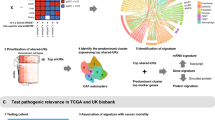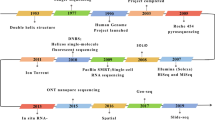Abstract
FAM50A encodes a nuclear protein involved in mRNA processing; however, its role in cancer development remains unclear. Herein, we conducted an integrative pan-cancer analysis using The Cancer Genome Atlas, Genotype-Tissue Expression, and the Clinical Proteomic Tumor Analysis Consortium databases. Based on the gene expression data from TCGA and GTEx databases, we compared FAM50A mRNA levels in 33 types of human cancer tissues to those in corresponding normal tissues and found that FAM50A mRNA level was upregulated in 20 of the 33 types of common cancer tissues. Then, we compared the DNA methylation status of the FAM50A promoter in tumor tissues to that in corresponding normal tissues. FAM50A upregulation was accompanied by promoter hypomethylation in 8 of the 20 types of tumor tissues, suggesting that promoter hypomethylation contributes to the upregulation of FAM50A in these cancer tissues. Elevated FAM50A expression in 10 types of cancer tissues was associated with poor prognosis in patients with cancer. FAM50A expression was positively correlated with CD4+ T-lymphocyte and dendritic cell infiltration in cancer tissues but was negatively correlated with CD8+ T-cell infiltration in cancer tissues. FAM50A knockdown caused DNA damage, induced interferon beta and interleukin-6 expression, and repressed the proliferation, invasion, and migration of cancer cells. Our findings indicate that FAM50A might be useful in cancer detection, reveal insights into its role in cancer development, and may contribute to the development of cancer diagnostics and treatments.







Similar content being viewed by others
Data availability
The datasets generated and/or analyzed during the current study are available from the corresponding author upon reasonable request.
Abbreviations
- GTEx:
-
Genotype-tissue expression database
- TIMER:
-
Tumor immune estimation resource
- GEPIA2:
-
Gene expression profiling interactive analysis 2
- UALCAN:
-
University of Alabama at Birmingham Cancer Data Analysis Portal
- TILs:
-
Tumor-infiltrating lymphocytes
- TISIDB:
-
Tumor–immune system interactions database
- KEGG:
-
Kyoto Encyclopedia of Genes and Genomes
- GO:
-
Gene Ontology
- BLCA:
-
Bladder urothelial carcinoma
- BRCA:
-
Breast invasive carcinoma
- CHOL:
-
Cholangiocarcinoma
- COAD:
-
Colon adenocarcinoma
- ESCA:
-
Esophageal carcinoma
- HNSC:
-
Head and neck squamous cell carcinoma
- KICH:
-
Kidney chromophobe
- KIRC:
-
Kidney renal clear cell carcinoma
- KIRP:
-
Kidney renal papillary cell carcinoma
- LIHC:
-
Liver hepatocellular carcinoma
- LUAD:
-
Lung adenocarcinoma
- LUSC:
-
Lung squamous cell carcinoma
- PRAD:
-
Prostate adenocarcinoma
- READ:
-
Rectum adenocarcinoma
- STAD:
-
Stomach adenocarcinoma
- THCA:
-
Thyroid carcinoma
- UCEC:
-
Uterine corpus endometrial carcinoma
- DLBC:
-
Lymphoid neoplasm diffuse large B-cell lymphoma
- PAAD:
-
Pancreatic adenocarcinoma
- THYM:
-
Thymoma
- CPTAC:
-
Clinical proteomic oncology analysis
- OV:
-
Ovarian cancer
- LUNG:
-
Lung cancer
- GBM:
-
Glioblastoma multiforme
- TGCT:
-
Testicular cancer
- KIPAN:
-
Pan-kidney cohort
- GBMLGG:
-
Lower grade glioma and glioma
- COADREAD:
-
Colon adenocarcinoma
- MSI:
-
Microsatellite instability
- UCS:
-
Uterine carcinosarcoma
- SKCM:
-
Skin cutaneous melanoma
- UVM:
-
Uveal melanoma
- WT:
-
Wilms tumor
- DFS:
-
Disease-free survival
- DSS:
-
Disease-specific survival
- PFS:
-
Progression-free survival
- LGG:
-
Brain lower grade glioma
- SARC:
-
Sarcoma
- RT-PCR:
-
Real-time polymerase chain reaction
- HCC:
-
Hepatocellular carcinoma
- siRNA:
-
Small interfering RNA
References
Hanahan D. Hallmarks of cancer: new dimensions. Cancer Discov. 2022;12(1):31–46.
Sung H, et al. Global cancer statistics 2020: GLOBOCAN estimates of incidence and mortality worldwide for 36 cancers in 185 countries. CA Cancer J Clin. 2021;71(3):209–49.
Jeggo PA, Pearl LH, Carr AM. DNA repair, genome stability and cancer: a historical perspective. Nat Rev Cancer. 2016;16(1):35–42.
Chatterjee A, Rodger EJ, Eccles MR. Epigenetic drivers of tumourigenesis and cancer metastasis. Semin Cancer Biol. 2018;51:149–59.
Ma X, et al. Pan-cancer genome and transcriptome analyses of 1,699 paediatric leukaemias and solid tumours. Nature. 2018;555(7696):371–6.
Kandoth C, et al. Mutational landscape and significance across 12 major cancer types. Nature. 2013;502(7471):333–9.
Lawrence MS, et al. Discovery and saturation analysis of cancer genes across 21 tumour types. Nature. 2014;505(7484):495–501.
Toyoda A, et al. Isolation and analysis of a novel gene, HXC-26, adjacent to the rab GDP dissociation inhibitor gene located at human chromosome Xq28 region. DNA Res. 1996;3(5):337–40.
Haghshenas S, et al. Detection of a DNA methylation signature for the intellectual developmental disorder, X-linked, syndromic, armfield type. Int J Mol Sci. 2021;22(3):1111. https://doi.org/10.3390/ijms22031111.
Mazzarella R, et al. Differential expression of XAP5, a candidate disease gene. Genomics. 1997;45(1):216–9.
Kim Y, et al. The Fam50a positively regulates ameloblast differentiation via interacting with Runx2. J Cell Physiol. 2018;233(2):1512–22.
Lee YR, et al. Mutations in FAM50A suggest that Armfield XLID syndrome is a spliceosomopathy. Nat Commun. 2020;11(1):3698.
Thompson NA, et al. Combinatorial CRISPR screen identifies fitness effects of gene paralogues. Nat Commun. 2021;12(1):1302.
Amin NA, et al. A quantitative analysis of subclonal and clonal gene mutations before and after therapy in chronic lymphocytic leukemia. Clin Cancer Res. 2016;22(17):4525–35.
Xie X, et al. Proto-oncogene FAM50A can regulate the immune microenvironment and development of hepatocellular carcinoma in vitro and in vivo. Int J Mol Sci. 2023;24(4):3217. https://doi.org/10.3390/ijms24043217.
Tang KF, et al. Decreased Dicer expression elicits DNA damage and up-regulation of MICA and MICB. J Cell Biol. 2008;182(2):233–9.
Li T, et al. TIMER: a web server for comprehensive analysis of tumor-infiltrating immune cells. Cancer Res. 2017;77(21):e108–10.
Tang Z, et al. GEPIA2: an enhanced web server for large-scale expression profiling and interactive analysis. Nucleic Acids Res. 2019;47(W1):W556–60.
Chandrashekar DS, et al. UALCAN: An update to the integrated cancer data analysis platform. Neoplasia. 2022;25:18–27.
Shen W, et al. Sangerbox: a comprehensive, interaction-friendly clinical bioinformatics analysis platform. iMeta. 2022;1:e36.
Ru B, et al. TISIDB: an integrated repository portal for tumor-immune system interactions. Bioinformatics. 2019;35(20):4200–2.
Ku JL, Jeon YK, Park JG. Methylation-specific PCR. Methods Mol Biol. 2011;791:23–32.
Bagci O, Kurtgoz S. Amplification of cellular oncogenes in solid tumors. N Am J Med Sci. 2015;7(8):341–6.
Wang Y, et al. Immune checkpoint modulators in cancer immunotherapy: recent advances and emerging concepts. J Hematol Oncol. 2022;15(1):111.
Thorsson V, et al. The immune landscape of cancer. Immunity. 2018;48(4):812–30.
Armfield K, et al. X-linked mental retardation syndrome with short stature, small hands and feet, seizures, cleft palate, and glaucoma is linked to Xq28. Am J Med Genet. 1999;85(3):236–42.
Kwon SM, et al. Global spliceosome activity regulates entry into cellular senescence. FASEB J. 2021;35(1): e21204.
Kumar D, et al. Degradation of splicing factor SRSF3 contributes to progressive liver disease. J Clin Invest. 2019;129(10):4477–91.
Chan YA, Hieter P, Stirling PC. Mechanisms of genome instability induced by RNA-processing defects. Trends Genet. 2014;30(6):245–53.
Stratigi K, Chatzidoukaki O, Garinis GA. DNA damage-induced inflammation and nuclear architecture. Mech Ageing Dev. 2017;165(Pt A):17–26.
Pilger D, Seymour LW, Jackson SP. Interfaces between cellular responses to DNA damage and cancer immunotherapy. Genes Dev. 2021;35(9–10):602–18.
Hopfner KP, Hornung V. Molecular mechanisms and cellular functions of cGAS-STING signalling. Nat Rev Mol Cell Biol. 2020;21(9):501–21.
Kostianets O, et al. Immunohistochemical analysis of medullary breast carcinoma autoantigens in different histological types of breast carcinomas. Diagn Pathol. 2012;7:161.
Kaaij LJ, et al. Enhancers reside in a unique epigenetic environment during early zebrafish development. Genome Biol. 2016;17(1):146.
Bunch BL, et al. Systemic and intravesical adoptive cell therapy of tumor-reactive T cells can decrease bladder tumor growth in vivo. J Immunother Cancer. 2020;8(2):e001673. https://doi.org/10.1136/jitc-2020-001673.
Hall M, et al. Expansion of tumor-infiltrating lymphocytes (TIL) from human pancreatic tumors. J Immunother Cancer. 2016;4:61.
Laidlaw BJ, Craft JE, Kaech SM. The multifaceted role of CD4(+) T cells in CD8(+) T cell memory. Nat Rev Immunol. 2016;16(2):102–11.
Baharom F, et al. Systemic vaccination induces CD8(+) T cells and remodels the tumor microenvironment. Cell. 2022;185(23):4317–32.
Farhood B, Najafi M, Mortezaee K. CD8(+) cytotoxic T lymphocytes in cancer immunotherapy: a review. J Cell Physiol. 2019;234(6):8509–21.
Fearon ER, et al. Interleukin-2 production by tumor cells bypasses T helper function in the generation of an antitumor response. Cell. 1990;60(3):397–403.
Borst J, et al. CD4(+) T cell help in cancer immunology and immunotherapy. Nat Rev Immunol. 2018;18(10):635–47.
Huang R, Zhou PK. DNA damage repair: historical perspectives, mechanistic pathways and clinical translation for targeted cancer therapy. Signal Transduct Target Ther. 2021;6(1):254.
Lord CJ, Ashworth A. The DNA damage response and cancer therapy. Nature. 2012;481(7381):287–94.
Acknowledgements
We are grateful to all of those with whom we have had the pleasure to work during this and other related projects.
Funding
This work was supported by the National Natural Science Foundation of China (Grant Numbers 81972648, 82172915, and 81773011) and the Chongqing Medical University Program for Youth Innovation in Future Medicine (Grant Number W0084).
Author information
Authors and Affiliations
Contributions
All authors contributed to the study conception and design. MZH, ZZD, HYJ, AQZ, HL, MMS, and JNL performed the experiments and analyzed the data. The first draft of the manuscript was written by MZH. KF Tang reviewed the manuscript. SJZ and KJW supervised the study. All authors have read and approved the final manuscript.
Corresponding authors
Ethics declarations
Conflict of interest
The authors have no relevant financial or nonfinancial interests to disclose.
Ethical approval
The Ethics Committee of ChongQing Medical University has confirmed that no ethical approval is required.
Additional information
Publisher's Note
Springer Nature remains neutral with regard to jurisdictional claims in published maps and institutional affiliations.
Supplementary Information
Below is the link to the electronic supplementary material.
Rights and permissions
Springer Nature or its licensor (e.g. a society or other partner) holds exclusive rights to this article under a publishing agreement with the author(s) or other rightsholder(s); author self-archiving of the accepted manuscript version of this article is solely governed by the terms of such publishing agreement and applicable law.
About this article
Cite this article
Hu, MZ., Dai, ZZ., Ji, HY. et al. Upregulation of FAM50A promotes cancer development. Med Oncol 40, 217 (2023). https://doi.org/10.1007/s12032-023-02072-z
Received:
Accepted:
Published:
DOI: https://doi.org/10.1007/s12032-023-02072-z




